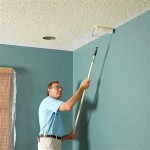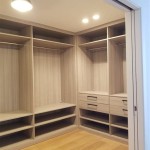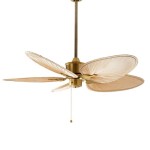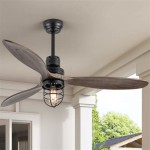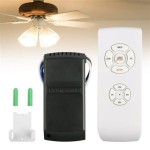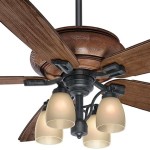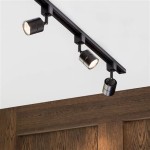Ceiling Hugger Ceiling Fan With Light: A Comprehensive Guide
Ceiling hugger ceiling fans with lights, also known as flush mount or low-profile ceiling fans, are designed for rooms with low ceilings. These fans minimize the distance between the fan blades and the ceiling, maximizing headroom and preventing the fan from becoming an obstruction. They effectively circulate air and provide illumination, making them a practical and space-saving solution for smaller rooms, bedrooms, kitchens, and other areas where ceiling height is a concern. Choosing the right ceiling hugger fan involves careful consideration of several factors, including room size, blade span, motor efficiency, lighting features, and overall design aesthetics.
Understanding the Need for Ceiling Hugger Fans
Traditional ceiling fans are typically mounted with a downrod, which extends the fan several inches below the ceiling. In rooms with standard or high ceilings, this is generally not an issue. However, in rooms with ceilings lower than 8 feet, a standard ceiling fan can create a feeling of claustrophobia, and the blades might be close enough to the floor that they pose a safety hazard. Ceiling hugger fans address this problem by mounting directly to the ceiling bracket, minimizing the overall height of the fan. This design allows for effective air circulation without compromising headroom or posing a safety risk. The selection of a ceiling hugger fan is crucial for maintaining comfort and safety in these confined spaces.
Beyond practicality, ceiling hugger fans also contribute to the visual appeal of a room. Standard fans in low-ceiling rooms can appear disproportionately large and dominating. A flush mount fan, on the other hand, integrates more seamlessly into the ceiling, creating a cleaner and less cluttered look. The streamlined design of these fans makes them a suitable option for modern and minimalist interior designs. The available styles and finishes vary widely, allowing homeowners to select a fan that complements the existing décor.
Key Features and Considerations
When selecting a ceiling hugger ceiling fan with light, several key features should be considered to ensure optimal performance and suitability for the intended space. These features influence air circulation efficiency, lighting quality, noise level, and overall energy consumption.
Blade Span and Pitch: The blade span refers to the diameter of the circle swept by the fan blades. For smaller rooms (under 75 square feet), a blade span of 42 inches or less is typically sufficient. For medium-sized rooms (75-150 square feet), a 44-52 inch blade span is recommended. Larger rooms might benefit from a 52-inch or larger fan, although using multiple fans is often a more effective solution for very large spaces. The blade pitch, which is the angle of the blades, also affects air circulation. A steeper blade pitch generally moves more air, but it can also increase noise levels and energy consumption. A moderate blade pitch offers a balance between air movement and efficiency.
Motor Type and Efficiency: Ceiling fan motors are typically either AC (alternating current) or DC (direct current). AC motors are generally less expensive, but DC motors are more energy-efficient and often quieter. DC motors also allow for a wider range of speed settings, providing greater control over airflow. When choosing a ceiling fan, look for the Energy Star label, which indicates that the fan meets specific energy efficiency standards. Selecting an Energy Star-certified fan can lead to significant energy savings over time.
Lighting Options: Ceiling hugger fans with lights come with various lighting options, including integrated LED lights, incandescent bulbs, and halogen bulbs. LED lights are the most energy-efficient option, providing bright illumination while consuming significantly less power than traditional bulbs. They also have a longer lifespan, reducing the need for frequent replacements. Incandescent and halogen bulbs produce a warmer light, but they are less energy-efficient and have a shorter lifespan. The choice of lighting option depends on personal preference and the desired ambiance of the room. Some fans also offer dimming capabilities, allowing for further control over the lighting level. The color temperature of the light is also a factor to consider. Warmer color temperatures (around 2700-3000 Kelvin) create a cozy and inviting atmosphere, while cooler color temperatures (around 4000-5000 Kelvin) provide brighter, more focused illumination.
Control Methods: Ceiling hugger fans can be controlled using various methods, including pull chains, wall controls, and remote controls. Pull chains are the most basic option, allowing for adjustments to the fan speed and light. Wall controls offer a more convenient way to adjust the fan speed and light from a fixed location. Remote controls provide the greatest flexibility, allowing for adjustments from anywhere in the room. Some fans also offer smart home integration, allowing for control via smartphone apps or voice assistants. The preferred control method depends on personal preference and the desired level of convenience.
Construction Materials and Finish: The construction materials and finish of the ceiling fan affect its durability, appearance, and resistance to corrosion. Fan blades are typically made of wood, metal, or plastic. Wood blades offer a classic and elegant look, but they can be susceptible to warping in humid environments. Metal blades are more durable and resistant to warping, but they can be noisier than wood or plastic blades. Plastic blades are lightweight, affordable, and easy to clean. The finish of the fan housing and blades should complement the existing décor of the room. Common finishes include brushed nickel, oil-rubbed bronze, and white. Selecting a fan with a durable and corrosion-resistant finish is particularly important in bathrooms or kitchens.
Installation Considerations
Proper installation is crucial for ensuring the safe and efficient operation of a ceiling hugger fan. While some homeowners may be comfortable installing the fan themselves, it is generally recommended to hire a qualified electrician, especially if electrical wiring needs to be modified. Incorrect installation can lead to safety hazards, such as electrical shocks or the fan falling from the ceiling.
Structural Support: Before installing a ceiling fan, it is essential to ensure that the ceiling is adequately supported to handle the weight of the fan. Ceiling fans require a specialized ceiling fan-rated electrical box that is securely mounted to a ceiling joist. Standard electrical boxes are not designed to support the weight and vibration of a ceiling fan. If the existing electrical box is not fan-rated, it will need to be replaced. In some cases, additional bracing may be required to reinforce the ceiling joist.
Wiring Connections: Accurate and secure wiring connections are essential for the safe operation of the ceiling fan. The electrical wiring must be properly grounded to prevent electrical shocks. If the wiring is not properly connected, the fan may not function correctly, or it could pose a fire hazard. It is important to follow the manufacturer's instructions carefully when making wiring connections. If unsure about any aspect of the wiring, consult with a qualified electrician.
Blade Balancing: After installation, it is important to ensure that the fan blades are properly balanced. Unbalanced blades can cause the fan to wobble, which can be noisy and potentially damaging to the fan motor and ceiling. Most ceiling fans come with a blade balancing kit, which includes small weights that can be attached to the blades to correct any imbalances. Follow the instructions provided with the balancing kit to achieve optimal balance.
Benefits of Using Ceiling Hugger Fans with Lights
Ceiling hugger ceiling fans with lights offer several benefits, making them a practical and versatile choice for various spaces. These benefits extend beyond basic air circulation and illumination, contributing to improved comfort, energy efficiency, and aesthetic appeal.
Space-Saving Design: The primary benefit of ceiling hugger fans is their space-saving design. By mounting directly to the ceiling bracket, these fans minimize the overall height, making them ideal for rooms with low ceilings. This design maximizes headroom and prevents the fan from becoming an obstruction. In smaller rooms, every inch of space is valuable, and a ceiling hugger fan can make a significant difference in the perceived spaciousness of the room.
Improved Air Circulation: Ceiling fans, in general, promote air circulation, which can improve comfort and reduce energy costs. By circulating air, fans help to distribute warm air in the winter and cool air in the summer, reducing the need for heating and air conditioning. This can lead to significant energy savings over time. Ceiling hugger fans, despite their low profile, are effective at circulating air, providing a comfortable environment in smaller rooms.
Integrated Lighting: The integrated lighting feature of ceiling hugger fans provides both air circulation and illumination in a single fixture. This eliminates the need for separate ceiling lights, which can further save space and simplify wiring. The variety of lighting options available allows homeowners to choose a fan that meets their specific lighting needs and preferences. The ability to control the fan speed and light independently provides added convenience and versatility.
Aesthetic Enhancement: Ceiling hugger fans are available in a wide range of styles and finishes, allowing homeowners to select a fan that complements the existing décor of their home. The streamlined design of these fans can enhance the visual appeal of a room, creating a cleaner and more modern look. Whether the design aesthetic is traditional, contemporary, or minimalist, there is a ceiling hugger fan to match. The aesthetic enhancement provided by a ceiling fan can contribute to the overall comfort and enjoyment of the space.
Cost-Effectiveness: Compared to installing separate lighting and air conditioning systems, ceiling hugger fans are a cost-effective solution for both air circulation and illumination. The energy savings associated with improved air circulation can help to offset the initial cost of the fan over time. The long lifespan of LED lighting further contributes to cost savings by reducing the need for frequent bulb replacements. In the long run, a ceiling hugger fan can be a worthwhile investment that enhances both comfort and energy efficiency.

Forest Breeze Ceiling Hugger Fan By Rustic Lighting And Fans

Hampton Bay Stoneridge 52 In Indoor Led Matte Black Hugger Ceiling Fan With Light Kit 5 Reversible Blades And Motor 51829 The Home

52 Ceiling Fan With Blades And Light Kit Tmph52ob5 Chateau Lighting

Copper Canyon Broe Western Star Ceiling Hugger Fan

Hugger Ceiling Fans Low Profile

Private Brand Unbranded Hugger 44 In Led Matte White Ceiling Fan Al383cp Mwh The Home

Flush Mount Low Profile Ceiling Fans With Lights Delmarfans Com

52 Oil Rubbed Broe Hugger Ceiling Fan Led Cage Light 57t65 Lamps Plus With

Private Brand Unbranded Hugger 52 In Led Indoor Brushed Nickel Ceiling Fan With Light Kit Al383led Bn The Home

Southwest Ceiling Hugger Fan From The Store

